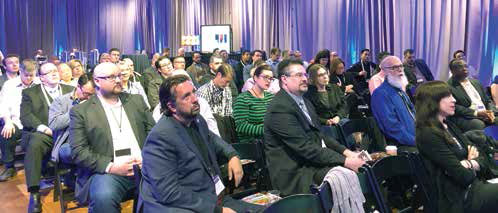Inside the AV/IT San Jose Summit

The only constant is flux, so how do stakeholders in the evolving AV/IT industry stay current with the trends poised to affect them now and in the future? The SCN Think Tank and AV/IT Summit, co-located in San Jose, CA, April 19, explored this question in depth. While the event’s brain trust was diverse—AV/IT managers, integrators, manufacturers, programmers, consultants, and content creators were in attendance—there was a surprising consensus: Focusing strategically on user experience (UX), standardization, and storytelling will help solve problems today and usher in the next innovation wave. Here are some of the lessons learned and hard truths shared at this unique AV/IT symposium.
CREATE EXPERIENCES YOU CAN’T GET AT HOME
Walt Disney invented the modern theme park, and Walt Disney Imagineering, the company’s AV engineering talent, is continually inventing its future. The San Jose Think Tank/Summit’s keynote speaker, Greg Kadorian, had worked for Walt Disney Imagineering for more than 30 years before recently retiring. During his Imagineering tenure, Kadorian received a patent for Star Tours and developed many of the AV innovations in use at Disney Theme Parks worldwide.
While Kadorian is one of the industry’s premier technical experts, and he has vast experience with VLANs, QLAN, AVB/TSN, and other AV-over-IP iterations, he warned against AV engineers spending all of their time on network infrastructure, and he underscored the importance of collaborations that utilize AV to build memorable, narrative-driven experiences.
“We create attractions and venues that tell a story in a unique and entertaining way,” Greg Kadorian said. “And we create immersive environments. In the past, [they’ve] been very passive experiences. Now, we’re moving toward more guest interaction, so it’s not the same experience every time, because we have a lot of repeat guests.”
One of the challenges Kadorian proffered was that there are still no seamless ways to integrate AV, AR, and VR for thousands of guests at larger scales while still offering the dynamic immersion that makes Disney such a beloved destination. “VR and AR? I don’t know,” he said. “Our R&D guys are working on stuff as we speak, to try to figure out how to do that with, again, thousands of people an hour through the attraction, or through the experience.”
As real as the challenges are, the possibilities are endless. Expect the Disney team to be solving these creative puzzles in the near future.
A daily selection of features, industry news, and analysis for tech managers. Sign up below.
UX: MAKE IT EASY TO USE, BUT ANCHOR IT IN REAL USER NEEDS

Culture influences everything, from fashion to coffee, and technology is no exception. How can AV technology managers tasked with rapid global deployments offer consistent UX across locations without sacrificing nuance or cultural sensitivity?
Think about sensible standardization, where scale can be achieved and complexity avoided, suggested Mohammad Sigari, senior AV engineer at Uber. Trying to offer too much can result in an inscrutable control interface, for example, with unclear functions and a clunky GUI that is difficult to navigate.
Cohesive UX requires usability testing and a solid understanding of the evolving needs of users. How important is BYOx? What are the ages of your users? You can also select a “power user,” as Sigari explained, a process that has helped to make Uber’s global AV rollouts more efficient.
SOFTWARE-BASED AV NEEDS SOLID PLANNING
The panelists also drilled down into the new AV/IT model and software-based AV designs through explorations of needs analysis, upgrade paths, and network investment.
At the University of California Berkeley’s College of Environmental Design, lifecycle has myriad definitions. “On the one hand, it’s about money. On the other hand, it’s about frequency of updates. The money informs the other,” said Patty Mead, assistant dean, Infrastructure and Information Technologies, UC Berkeley. “What we do is we build our own machines with replaceable parts so that as the technology changes, I just have to change a component.”
The migration of AV to the network is ushering many changes and upending the once five- or 10-year hardware lifecycle. Security concerns are paramount, but all the panelists agreed that software-based AV is creating more flexible lifecycles and quicker planning.
Margot Douaihy is the editor-at-large of AV Technology. Cindy Davis contributed to this story. Join us at the next SCN Think Tank & AV/IT Summit in Chicago on July 25, 2018. IT/AV managers can register for an invitation via https://www.avitsummit.com/.
Margot Douaihy, Ph.D., is a lecturer at Franklin Pierce University.


